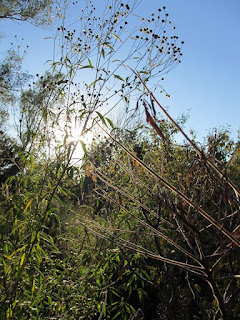The assertion is that native plant cultivars -- those bred and crossed to produce new plants different from the straight species parents (not wild-found offshoots) -- are just as beneficial to wildlife and pollinators.
This is an assertion, and assumption, that highlights our hubris. We don't have the research yet, or the funds to produce it, that shows cultivars play the same ecological role in their environments as straight species. We need to test the nectar and pollen chemical makeup, as well as the leaves, just to hit the surface (keeping in mind most pollinator species are nectar generalists, so it's the more nutritious pollen we really need to look at, as well as leaf chemistry for egg laying). What animal and insect species are using cultivars vs. straight species, and how are they using them? How does that compare to straight species plants and wild selections? And what about geographic location or ecoregions? What about the role that plant plays in the ecosystem beyond pollen and being a host, like soil life? Can you imagine how much money and time this would require?
It seems totally logical to me to believe and accept that straight species plants fit a niche we can't easily define or explore, certainly not in a limited time frame and with few monetary resources. It seems totally acceptable to embrace the idea that evolution knows best, that the planet knows better than we do. We are so quick to change and alter and augment without understanding very much of our world, and we do it with plant breeding -- in the ornamental plant trade, we do it for purely aesthetic reasons. Totally selfish reasons. To defend hybrid cultivars is to defend a way of garden making that exploits life for our personal pleasure. That selfishness is reflected in other areas of our existence: by producing a garbage patch bigger than Texas in the Pacific, that 50% of all seabirds have plastic in their stomachs, and why tar sand oil extraction projects exist -- this world is not just for us, and when we act, think, and live in this way our lives are greatly diminished. I'd even argue we become more apt to violence and distrust, closing ourselves off from other perspectives or unable to think critically about complex issues that challenge our assumptions or status quo.
And here's something else -- are we insulting plant dignity by altering them for our purposes? Does are manipulation of life on the genetic level show how myopic we are, how little we care for the world? How far can we go in altering ecosystems and eco functions before we've crossed a line we can't return to? What are the repercussions of crossing that line? A lot of environmental literature points to our lost connection -- and certainly, we hope gardens rebuild that connection; but how can gardens do that when they are composed of plants altered for our aesthetic pleasure, or gathered from places far and wide then plunked down in a place where they fill no evolutionary niche or can't provide multiple ecosystem services above and below the soil line like their native counterparts? (The natives also need to be studied a lot more.)
The argument will be plants and animals move and migrate; yes, they do, but never with such speed and reckless abandon as in the last 100-200 years. We have accelerated natural processes and made them unnatural. Our species has become a land bridge, a stiff wind, ocean currents, ice ages, meteors, volcanoes, floods, wildfires, droughts all wrapped into one. We're experimenting and don't understand the base that such experimentation comes from. It's dangerous on a metaphysical level, it may be catastrophic on a physical level. It IS proving disastrous, as habitat loss is the number one driver of vanishing species, loss caused by climate change, invasive species, roads, farms, cities, lawns....
Why do gardens matter? Because they are the main entry point for so many of us into the natural world. Because when they are linked together they become de facto wildlife refuges. Because gardens can heal the rift between our conflicted, complicated selves and the world we come from -- a world whose natural process can teach us how to live better lives if we become a part of those processes, not work to be apart from them. Nature heals. The act of gardening smarter, and with an ethical awareness that is expansive (includes the non human world / perspective), will always bring us closer to our home.


















































